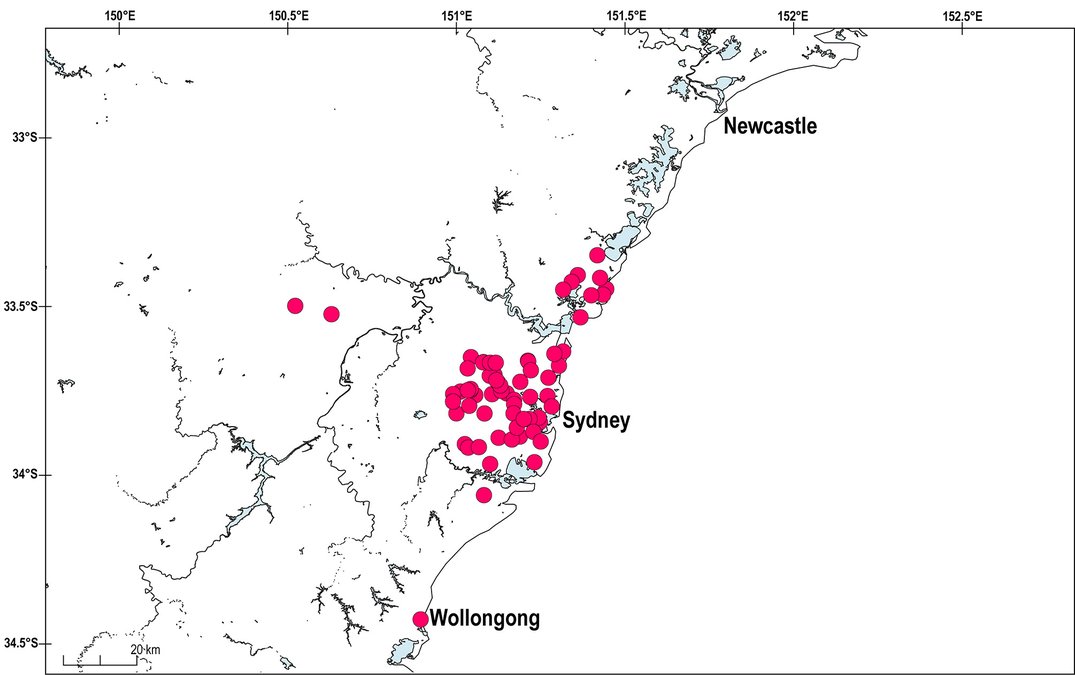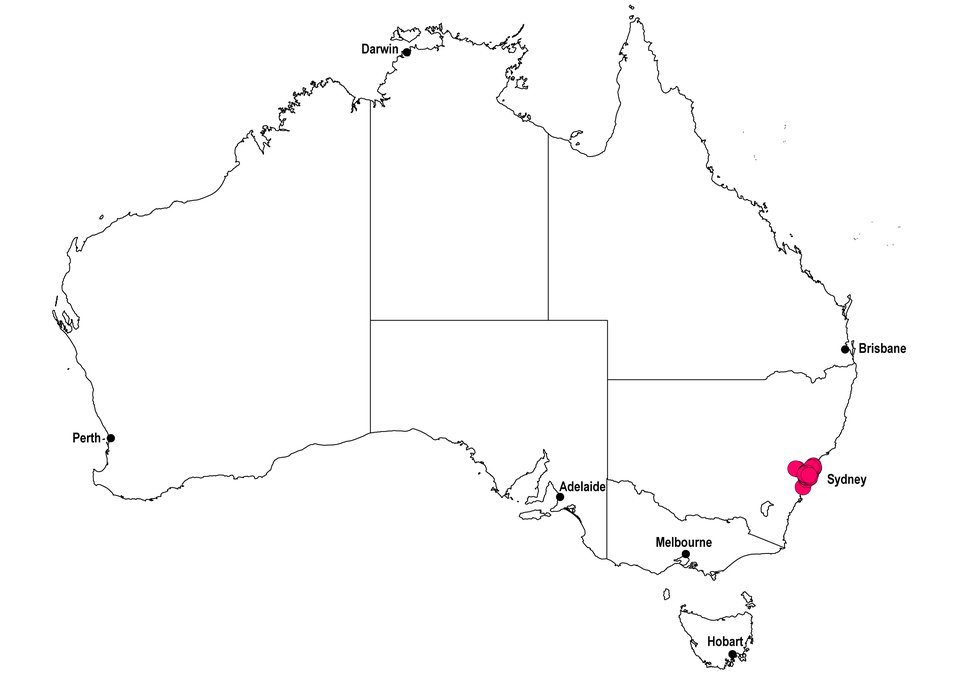Sydney Funnel-web Spider, Atrax robustus
Sydney Funnelweb Spider, Funnel Web Spider
Probably the most notorious of all spiders, Sydney Funnel-webs have a fearsome reputation. Most of this is deserved, but some is exaggerated.
What do Sydney Funnel-web Spiders look like?
Identification
Sydney Funnel-webs are shiny, dark brown to black spiders with finger-like spinnerets (silk-spinning organs) at the end of their abdomen. Males have a large mating spur projecting from the middle of their second pair of legs. This species cannot easily be separated from the Southern Sydney Funnel-web by eye. If threatened, both species show aggressive behaviour, rearing and displaying their impressive fangs.

© Australian Museum
Where do Sydney Funnel-web Spiders live?
Habitat
Bushy suburban areas, open and closed sclerophyll forests and woodlands, often on south or east-facing slopes or in shady gullies.
Distribution
The main range of the Sydney Funnel-web is from the Central Coast south to the Georges River, extending as far west as Baulkham Hills near the southern end of its distribution. Some records are also known from the Blue Mountains and Wollongong. More recently, the range is reduced in the south, with the few recent records from south of the Parramatta River limited to the Bankstown–Mortdale area. The species distribution overlaps with the recently separated Southern Sydney Funnel-web, A. montanus.
Map of Atrax robustus records created using QGIS v.3.14.16 (https://www.qgis.org) by superimposing locality records from Loria et al. (2025) on lakes and rivers from Geoscience Australia (Crossman 2015); and borders and coastlines from Natural Earth (https://www.naturalearthdata.com).
What do Sydney Funnel-web Spiders eat and how do they mate?
Feeding and diet
Sydney Funnel-webs live in silk-lined burrows in sheltered sites under logs and rocks in areas where they can maintain a cool and humid climate. When hungry, the spider waits inside the burrow entance ready to rush out when potential prey, such as beetles, cockroaches, small lizards or millipedes, walk across silken trip-lines that the spider has placed around the outside of its burrow. They then return to their burrow to eat their meal.

© Braxton Jones
Other behaviours and adaptations
Male funnel-web spiders have a habit of wandering into backyards and falling into suburban swimming pools, where they can survive many hours. They also sometimes enter and become trapped in houses. Dry daytime surface conditions will dehydrate funnel-web spiders and also expose them to birds and lizards. This is why males that have spent the humid night in search of a female have to seek cover at dawn. This can be any suitable hideaway that is dark, moist and cool, like a cavity under a rock, or even in a shoe left outdoors.
A number of other spiders are often mistaken for funnel-webs, including mouse spiders, trapdoor spiders and even Black House Spiders. Always seek urgent first aid if a bite might have been inflicted by a funnel-web.
Breeding behaviours
Males leave their burrows and wander, mostly over summer and autumn to find females and mate.

© Braxton Jones
Are Sydney Funnel-web Spiders dangerous?
Danger to humans
Funnel-web bites are dangerous and first aid should be given immediately using the pressure bandage/immobilisation technique (as for snake bite) and the victim taken to hospital and given antivenom if necessary. The venom has a neurotoxin component that attacks the human nervous system and, in the worst cases, can result in death. However, there have been no fatalities since the introduction of antivenom.
References
- Bradley, R. A. (1993). Seasonal activity patterns in Sydney funnel-web spiders, Atrax spp. (Araneae: Hexathelidae). Bulletin of the British Arachnological Society, 9(6), 189–192
- Isbister, G, Gray, M, Balit, C, Raven, R, Stokes, B, Porges, K, Tankel, A, Turner, E, White, J, and Fisher, M. 2005. Funnel-web spider bite: a systematic review of recorded clinical cases. Medical Journal of Australia 182(8): 407-411.
- Gray, M. 2010. A revision of the Australian funnel-web spiders (Hexathelidae: Atracinae). Records of the Australian Museum 62: 285-392.
- Loria, S.F., Frank, SC., Dupérré, N. et al. The world’s most venomous spider is a species complex: systematics of the Sydney funnel-web spider (Atracidae: Atrax robustus). BMC Ecol Evo 25, 7 (2025). https://doi.org/10.1186/s12862-024-02332-0
- Crossman S, Li O. Surface Hydrology Polygons (National). Geoscience Australia, Canberra. 2015. https://pid.geoscience.gov.au/dataset/ga/83135




